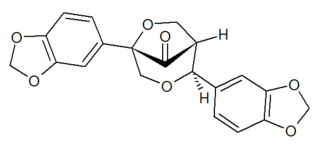
Gmelina arborea,, locally known as gamhar, is a fast-growing deciduous tree in the family Lamiaceae.

The Pauson–Khand reaction is a chemical reaction described as a [2+2+1] cycloaddition between an alkyne, an alkene and carbon monoxide to form a α,β-cyclopentenone. Ihsan Ullah Khand (1935-1980) discovered the reaction around 1970, while working as a postdoctoral associate with Peter Ludwig Pauson (1925–2013) at the University of Strathclyde in Glasgow. Pauson and Khand's initial findings were intermolecular in nature, but starting a decade after the reaction's discovery, many intramolecular examples have been highlighted in both synthesis and methodology reports. This reaction was originally mediated by stoichiometric amounts of dicobalt octacarbonyl, but newer versions are both more efficient, enhancing reactivity and yield via utilizing different chiral auxiliaries for stereo induction, main group transition-metals, and additives.
The Staudinger reaction is a chemical reaction of an organic azide with a phosphine or phosphite produces an iminophosphorane. The reaction was discovered by and named after Hermann Staudinger. The reaction follows this stoichiometry:

Umbelliferone, also known as 7-hydroxycoumarin, hydrangine, skimmetine, and beta-umbelliferone, is a natural product of the coumarin family.

Tetrahedron is a weekly peer-reviewed scientific journal covering the field of organic chemistry. According to the Journal Citation Reports, Tetrahedron has a 2020 impact factor of 2.457. Tetrahedron and Elsevier, its publisher, support an annual symposium. In 2010, complaints were raised over its high subscription cost.

Fluspirilene is a diphenylbutylpiperidine typical antipsychotic drug, used for the treatment of schizophrenia. It is administered intramuscularly. It was discovered at Janssen Pharmaceutica in 1963. A 2007 systematic review investigated the efficacy of fluspirilene decanoate for people with schizophrenia:
The reduction of nitro compounds are chemical reactions of wide interest in organic chemistry. The conversion can be effected by many reagents. The nitro group was one of the first functional groups to be reduced. Alkyl and aryl nitro compounds behave differently. Most useful is the reduction of aryl nitro compounds.
The Skattebøl rearrangement is an organic reaction for converting a geminal dihalo cyclopropane to an allene using an organolithium base. This rearrangement reaction is named after its discoverer, Lars Skattebøl, Professor emeritus at the University of Oslo. It proceeds through a carbene reaction intermediate:
Neoflavonoids are a class of polyphenolic compounds. While flavonoids have the 2-phenylchromen-4-one backbone, neoflavonoids have the 4-phenylchromen backbone with no hydroxyl group substitution at position 2.

Arboreol is an epoxylignan.

Lavendamycin is a naturally occurring chemical compound discovered in fermentation broth of the soil bacterium Streptomyces lavendulae. Lavendamycin has antibiotic properties and anti-proliferative effects against several cancer cell lines. The use of lavendamycin as a cytotoxic agent in cancer therapy failed due to poor water solubility and non-specific cytotoxicity. The study of lavendamycin-based analogs designed to overcome these liabilities has been an area of research.

Gmelanone is a lignan found in the heartwood of Gmelina arborea. Arboreol can be transformed by acid catalysis into gmelanone.

Gmelinol is a lignan. (+)-Gmelinol can be isolated from the heartwood of Gmelina arborea. This compound, along with four other chemicals also found in the same species, (+)-7′-O-ethyl arboreol, (+)-paulownin, (+)-epieudesmin and (−)-β-sitosterol, shows antifungal activity against Trametes versicolor.
The Chan–Lam coupling reaction – also known as the Chan–Evans–Lam coupling is a cross-coupling reaction between an aryl boronic acid and an alcohol or an amine to form the corresponding secondary aryl amines or aryl ethers, respectively. The Chan–Lam coupling is catalyzed by copper complexes. It can be conducted in air at room temperature. The more popular Buchwald–Hartwig coupling relies on the use of palladium.
Ram Narayan Chakravarti (1916–2007) was an Indian phytochemist, scientist and the Director of the erstwhile Indian Institute of Experimental Medicine, known for his contributions to the science of medicinal chemistry. Born in 1916, he secured a DSc from Kolkata University and worked as a Professor and the deputy director of the Calcutta School of Tropical Medicine before becoming the director of the Indian Institute of Experimental Medicine. His researches were reported to have assisted studies of medicinal plants and have been documented by way of several articles published by him. He was a fellow of the Royal Society of Chemistry and an elected fellow of the Indian National Science Academy. The Government of India awarded him the third highest civilian honour of the Padma Bhushan, in 1972, for his contributions to science. He died on 31 May 2007, at the age of 91. The Post Graduate Institute of Medical Education and Research (PGIMER) has instituted an annual oration, Professor R.N. Chakravarti Memorial Oration Lecture, in honour of Chakravarti.
Ganugapati Sree Rama Subba Rao is an Indian natural product chemist and a former chair of the department of sciences at the Indian Institute of Science (IISc). He is known for his researches on dihydroaromatics obtained through Birch reduction of aromatic compounds and is an elected fellow of the Indian National Science Academy, and the Indian Academy of Sciences. The Council of Scientific and Industrial Research, the apex agency of the Government of India for scientific research, awarded him the Shanti Swarup Bhatnagar Prize for Science and Technology, one of the highest Indian science awards, in 1982, for his contributions to chemical sciences.
In organic chemistry, the Davis oxidation or Davis' oxaziridine oxidation refers to oxidations involving the use of the Davis reagent or other similar oxaziridine reagents. This reaction mainly refers to the generation of α-hydroxy carbonyl compounds (acyloins) from ketones or esters. The reaction is carried out in a basic environment to generate the corresponding enolate from the ketone or ester. This reaction has been shown to work for amides.

Delta-7-Tetrahydrocannabinol is a synthetic isomer of tetrahydrocannabinol. The (6aR,9S,10aR)-Δ7-THC epimer is only slightly less potent than Δ9-THC itself, while the (9R) enantiomer is much less potent.
In organic chemistry, the Lombardo methylenation is a name reaction that allows for the methylenation of carbonyl compounds with the use of Lombardo's reagent, which is a mix of zinc, dibromomethane, and titanium tetrachloride.

The epoxidation of allylic alcohols is a class of epoxidation reactions in organic chemistry. One implementation of this reaction is the Sharpless epoxidation. Early work showed that allylic alcohols give facial selectivity when using meta-chloroperoxybenzoic acid (m-CPBA) as an oxidant. This selectivity was reversed when the allylic alcohol was acetylated. This finding leads to the conclusion that hydrogen bonding played a key role in selectivity and the following model was proposed.











